

Enough with the CRAAP: We're just not doing it right - NeverEndingSearch. It’s not the web it used to be and our traditional approaches to teaching about it no longer make sense.
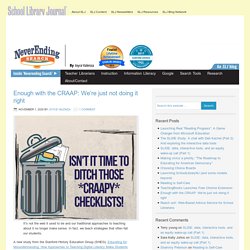
In fact, we teach strategies that often fail our students. A new study from the Stanford History Education Group (SHEG): Educating for Misunderstanding: How Approaches to Teaching Digital Literacy Make Students Susceptible to Scammers, Rogues, Bad Actors, and Hate Mongers, reveals some of the issues. Researchers studied 263 college students at a large East Coast state university and presented them with two tasks. The first asked students to evaluate the trustworthiness of a news story from a satirical website. Two-thirds of the students failed to recognize the article as satire. The Seattle Tribune is a news and entertainment satire web publication. . . .All news articles contained within The Seattle Tribune are fictional and presumably satirical. The second task asked students to evaluate the credibility of an article on the Minimumwage.com website. Students struggled. Six Fake News Techniques and Simple Tools to Vet Them. বাংলা | Русский | Français Exposing fake or manipulated images is quite possible with the proper tools and techniques.
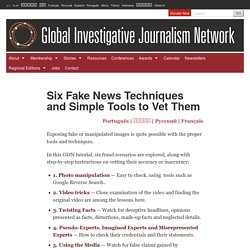
In this GIJN tutorial, six fraud scenarios are explored, along with step-by-step instructions on vetting their accuracy or inaccuracy: 1. Photo manipulation — Easy to check, using tools such as Google Reverse Search..2. Video tricks — Close examination of the video and finding the original video are among the lessons here.3. 1. Photo manipulation is the easiest way to fake news, but also the simplest to expose.
There are two common techniques of photo manipulation. The first is editing photos in special programs, such as Adobe Photoshop. EdWeb 2020 Resouces. Negotiating Nuance. Recently, I was honored to be invited to speak at the 21CLHK Conference in Hong Kong.
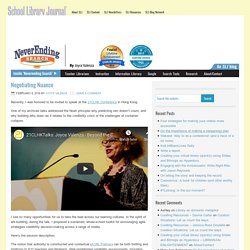
One of my archived talks addressed the Noah principle–why predicting rain doesn’t count, and why building arks does–as it relates to the credibility crisis or the challenges of container collapse. I see so many opportunities for us to take the lead across our learning cultures. In the spirit of ark-building, during the talk, I proposed a sustained, whole-school toolkit for encouraging agile strategies credibility decision-making across a range of media. Curated News Options. MediaSmarts. News & Media Literacy. National Association for Media Literacy Education. Questioning News - MEDIA LITERACY WEEK - Education. CRAAP Test Rumble – The Unquiet Librarian. Digitalliteracyinfo. On wrapping it up with a meme: reflecting on the semester. Each semester I ask my Search and the Information Landscape sections to reflect on their learning by thinking about it figuratively and metaphorically, visualizing the landscape and their place in it.
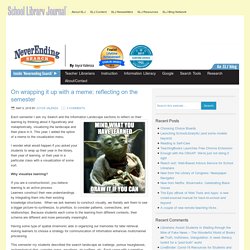
This year, I added the option of a meme to the visualization menu. 200 Purged. Developing students' digital literacy. The issue Even today’s students need support with some areas of digital practice, particularly in an academic context, so it’s important to make sure that these needs are met.
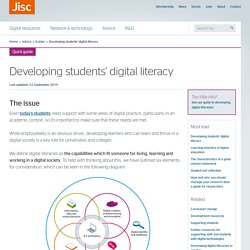
While employability is an obvious driver, developing learners who can learn and thrive in a digital society is a key role for universities and colleges. Framework for 21st Century Learning. WG Education Report2017. Technology Trends Reshape Today’s Libraries. Lifelong Kindergarten: Cultivating Creativity through Projects, Passion, Peers, and Play (MIT Press) (9780262037297): Mitchel Resnick, Ken Robinson: Books. What are the 21st-century skills every student needs? The gap between the skills people learn and the skills people need is becoming more obvious, as traditional learning falls short of equipping students with the knowledge they need to thrive, according to the World Economic Forum report New Vision for Education: Fostering Social and Emotional Learning Through Technology.
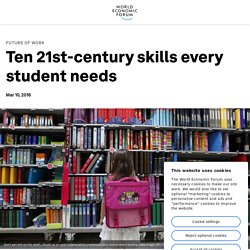
Today's job candidates must be able to collaborate, communicate and solve problems – skills developed mainly through social and emotional learning (SEL). Combined with traditional skills, this social and emotional proficiency will equip students to succeed in the evolving digital economy. What skills will be needed most? An analysis of 213 studies showed that students who received SEL instruction had achievement scores that averaged 11 percentile points higher than those who did not. And SEL potentially leads to long-term benefits such as higher rates of employment and educational fulfillment.
63 Things Every Student Should Know In A Digital World. 63 Things Every Student Should Know In A Digital World by Terry Heick ed note: this has been updated from a previous post.
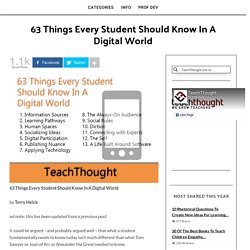
What is digital fluency? Image by George Couros under CC A recent announcement from Hon. Hekia Parata signalled that digital fluency will be a key focus for Ministry centrally-funded professional learning support in 2016 (PLD Changes will lift student achievement, 23 Sept. 2015). The value of growing digitally fluent learners was signalled in the Ministry report, Future Focused Learning in Connected Communities (2014) which asked that “digital competencies be recognised as “essential foundation skills for success in 21st century society” and that they be supported by “cross-curriculum resources, a responsive assessment framework, professional development and a programme of evaluation.” Digital fluency / Teaching. What is digital fluency?
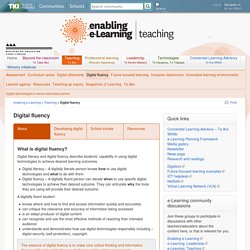
Digital literacy and digital fluency describe students' capability in using digital technologies to achieve desired learning outcomes. Digital literacy – A digitally literate person knows how to use digital technologies and what to do with them. Digital fluency – A digitally fluent person can decide when to use specific digital technologies to achieve their desired outcome. They can articulate why the tools they are using will provide their desired outcome. A digitally fluent student: Website Evaluation - The Preuss School - LibGuides at University of California San Diego. Schools will teach 'soft skills' from 2017, but assessing them presents a challenge.
For Students 2016. 2b Students engage in positive, safe, legal and ethical behavior when using technology, including social interactions online or when using networked devices.
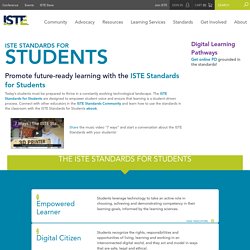
CRAAP Test handout. Jenny Luca - Toorak College Information Fluency Program. Toorak College Information Fluency ProgramCC BY-NC-SAAttribution-NonCommercial-ShareAlikeAt Toorak College the teaching and learning of information fluency skills is embedded in the dissemination of an integrated curriculum.
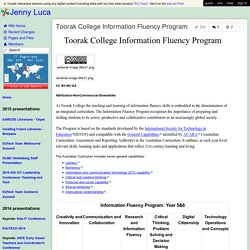
The Information Fluency Program recognises the importance of preparing and skilling students to be active, productive and collaborative contributors in an increasingly global society. The Program is based on the standards developed by the International Society for Technology in Education(ISTE®) and compatible with the General Capabilities identified by ACARA (Australian Curriculum, Assessment and Reporting Authority) in the Australian Curriculum. It outlines, at each year level, relevant skills, learning tasks and applications that reflect 21st century learning and living. The Australian Curriculum includes seven general capabilities: Digital literacy model explained.